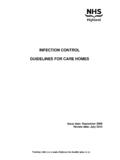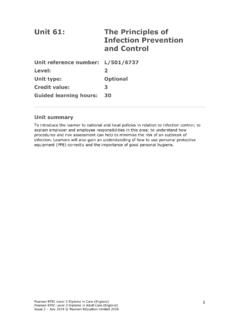Transcription of COVID-19 Quick Reference SOPs
1 Version 5. 04 March 2020. COVID-19 Quick Reference SOPs Contents INFORMATION ABOUT FREQUENTLY ASKED QUESTIONS: COVID-19 .. 3. COVID-19 CASE DEFINITION FOR A SUSPECTED CASE (as of 28th February 2020): .. 4. COVID-19 : INITIAL RESPONSE AT HEALTH FACILITY .. 5. PERSONAL PROTECTIVE EQUIPMENTS: COVID -19 .. 6. PERSONAL PROTECTIVE EQUIPMENTS: COVID -19 .. 7. FACIAL HAIRSTYLES FOR HCWS USING N95 MASKS .. 8. SEQUENCE FOR PUTTING ON PERSONAL PROTECTIVE EQUIPMENT (PPE) .. 9. SEQUENCE FOR PUTTING OFF PERSONAL PROTECTIVE EQUIPMENT (PPE) x1 .. 10. SEQUENCE FOR PUTTING OFF PERSONAL PROTECTIVE EQUIPMENT (PPE) x2 .. 11. CLEANING PROCEDURES .. 13. SPILL 14. PROTOCOL FOR TRANSPORTATION OF PATIENTS WITH SUSPECTED COVID-19 INFECTION .. 15. SAMPLE COLLECTION PROTOCOL .. 16. VIROLOGIC EVALUATION OF SUSPECTED COVID 19 17. TRIAGE AND CLINICAL MANAGEMENT OF A CASE OF SUSPECTED COVID-19 18.
2 CLINICAL SYNDROMES ASSOCIATED WITH COVID-19 INFECTION .. 19. TRIAGE AND MANAGEMENT OF A CASE OF SUSPECTED COVID-19 INFECTION .. 21. CLINICAL MANAGEMENT OF SARI IN ADULTS WHEN COVID-19 IS SUSPECTED .. 22. MANAGEMENT OF 23. EXPOSURE RISK CATEGORIZATION (contacts) .. 24. COVID-19 HEALTH FACILITY PREPAREDNESS CHECK LIST .. 25. PUBLIC HEALTH RISK LEVEL AND RESPONSE: COVID -19 .. 29. Version 5 2. INFORMATION ABOUT FREQUENTLY ASKED QUESTIONS: COVID-19 . Disease Organism Incubation SARS- coronavirus-2. period Coronavirus disease 2019 (SARS-CoV-2) Most estimates ( COVID-19 ) show about 1-14. days Modes of transmission Symptoms Period of Person to person infectivity spread via respiratory droplets produced Fever (some people may not have fever). when an infected Cough Not sure person coughs or Shortness of breath Asymptomatic sneezes (usually transmission within 6 feet distance).
3 Possible Spread from contact with infected surfaces or object Risk groups Outcome Elderly People with underlying conditions like hypertension, COPD/ other chronic lung conditions, diabetis and other Severe disease in 15-20% cardiovasccular and cerebrovascular Critical care needed in ~ 3-5% conditions and immunocompromising Mortality ~ 1-2% conditions Smokers Pregnancy Version 5 3. COVID-19 CASE DEFINITION FOR A SUSPECTED CASE (as of 28th February 2020): A. Patient with any acute respiratory illness (fever* and at least one sign/symptom of respiratory disease ( , cough, shortness of breath), AND. no other etiology that fully explains the clinical presentation AND. a history of travel to or residence in a country/area or territory reporting local transmission of COVID-19 disease during the 14 days prior to symptom onset. OR. B. Patient with any respiratory illness AND.)
4 Having been in contact with a confirmed or probable COVID-19 case in the last 14 days prior to onset of symptoms OR. C. Patient with SARI. AND. no other etiology that fully explains the clinical presentation SARI is defined as an acute respiratory infection (ARI) with history of fever* or measured temperature 380C and cough; with onset within last 14 days and requiring admission to hospital. *Absence of fever does NOT exclude viral infection Please follow WHO daily situation updates 2019/situation-reports Version 5 4. COVID-19 : INITIAL RESPONSE AT HEALTH FACILITY. Patient with sever acute respiratory infection (SARI). OR. Patient with acute respiratory infection (ARI) AND. Contact with suspected or confirmed COVID-19 . Identify patient OR. Travel to COVID-19 affected area Cases Give medical mask Isolate patient (keep in a seperate room or maintain 3 feet between patients).
5 Prevent Cover cough with tissue and discard in lined dustbin Frequently wash hands with soap and water/ use transmission alcohol based hand rub HCW wear medical mask, goggles, gloves and gown Use dedicated equipment for patient OR clean after use (stethoscope maybe wiped with a 70% isopropyl alcohol solution). Protect Frequently wash hands with soap and water / use alcohol based hand rubs (HCW & close contacts). Call HPA 1676. Inform HPA. Version 5 5. PERSONAL PROTECTIVE EQUIPMENTS: COVID -19. Contact and Droplet precaution STOP Note: For aerosol generating procedure (such as open STOP. suctioning/ intubation use contact and airborne precaution Clean hands, including before entering and when leaving the room With soap and water if visibly soiled or Alcohol based hand rub GOWNS. Put on gown before room gown before room exit Do not wear the same gown and gloves for the care of more than one person.)
6 MASK and goggles / face shield Make sure their eyes, nose and mouth are fully covered before room entry Remove face protection before room exit. GLOVES. Put on gloves before room entry. Discard gloves before room exit DEDICATED EQUIPMENTS. Use dedicated or disposable equipment. Clean and disinfect reusable equipment before use on another person Version 5 6. PERSONAL PROTECTIVE EQUIPMENTS: COVID -19. AIRBORNE and CONTACT precaution STOP Aerosol generating procedures: STOP. Open suctioning, intubation, sputum induction etc. Clean hands, including before entering and when leaving the room Use soap and water if visibly soiled or Alcohol based hand rub GOWNS. Put on gown before room gown before room exit Do not wear the same gown and gloves for the care of more than one person. USE N-95 MASK. Make sure their eyes, nose and mouth are fully covered before room entry Remove mask AFTER room exit.
7 EYE PROTECTION with GOGGLES. Make sure their eyes are fully covered before room entry Remove eye /face protection just before room exit/ in anteroom if available. GLOVES. Put on gloves before room entry. Discard gloves before room exit DOOR TO ROOM MUST REMAIN CLOSED. Version 5 7. FACIAL HAIRSTYLES FOR HCWS USING N95 MASKS. Version 5 8. SEQUENCE FOR PUTTING ON PERSONAL PROTECTIVE. EQUIPMENT (PPE). Type of PPE used will vary based on the level of precaution Wash hands -> Gown -> Mask or Respirator -> Goggles or Face Shield -> Gloves Version 5 9. SEQUENCE FOR PUTTING OFF PERSONAL PROTECTIVE. EQUIPMENT (PPE) x1. Remove: Gloves -> Gown -> Goggles or Face Shield -> Mask or Respirator Version 5 10. SEQUENCE FOR PUTTING OFF PERSONAL PROTECTIVE. EQUIPMENT (PPE) x2. Remove: Gloves -> Goggles or Face Shield -> Gown -> Mask or Respirator Version 5 11.
8 Important points: PPE. o Sequence of putting on PPE: Wash hands -> Gown -> Mask or Respirator -> Goggles or Face Shield - > Gloves o Sequence for removing PPE. Remove: Gloves -> Gown -> Goggles or Face Shield ->. Mask or Respirator and wash hands OR. Gloves -> Goggles or Face Shield -> Gown -> Mask or Respirator and Wash hands Clean areas you can touch while removing o The inside and back of the gown, gown's ties, inside of the gloves, ear pieces/straps of mask/goggles/respirator/face shield Dirty area you CAN'T touch while removing o Outside the front of the gloves, gown (includes sleeves), and outside of the mask, face shield, goggles, respirator o If you touch any of the dirty parts while removing PPE, perform hand hygiene with soap and water or alcohol based hand rub and then move to the next step of removal of PPE. Version 5 12.
9 CLEANING PROCEDURES. Use soap and water OR alcohol based hand rub (>60% ABHR). before starting to clean Hand SOAP AND WATER is preferred if hands are visibly soiled, after going to toilet, after cleaning procedures and before Hygeine eating. Dry hands preferrably with disposalble paper towels/tissue or use clean cloth towels and replace them when wet. Personal Protective Equipment (PPE). Before starting to clean wear PPE: Gloves, Mask, Water proof apron/gowns, Goggles / face shield Clean with soap/detergent & water -> Rinse with water -> disinfect with bleach in the following dilution Surfaces and reusable Surfaces in patient area diluted bleach solution 1ml materials bleach in : 9ml water and keep for 10min contact time (bed room furnitures, bath room, The bleach solution should be prepared fresh every 24. heavy duty gloves) hourly and kept in closed container If diluted bleach solution cannot be used on a surface (like metal) 70% ethanol maybe used Use a laundry bag to collect dirty laundry do not carry dirty clothes against your body and do not shake clothes linen / laundry and Wash clothes with laundry detergent/soap in hot water (60-90 oC) and dry well.
10 Bleach maybe added if available. utensils Plates : Wash with regular dish washing liquid and dry. The plates can be reused. Do not share towels /beds/clothes/plates Usual public areas should be cleaned by soap/detergent and water -> rinse with water AND areas where people touch frequently should be cleaned with diluted bleach solution 1ml bleach: in 49ml water or 70%. ethanol solution if bleach cannot be used (like on metal surface). Exposed surfaces where a suspected patient has been should be cleaned with bleach solution 1: 9ml water as given above. When handling dead body wear: Gloves, Mask, water resistant Gown and Apron. If any splash is expected use Goggles /Face shield to protect eyes. Used masks, gloves and other waste should be discarded in a dustbin lined with a water proof bag inside it. When the dustbin is 2/3rd full the bag should be sealed closed and taken to waste disposal area marked as infectious waste.









